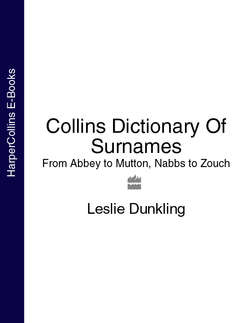Читать книгу Collins Dictionary Of Surnames: From Abbey to Mutton, Nabbs to Zouch - Leslie Dunkling - Страница 8
BY-NAMES
ОглавлениеThe Normans shared the same ideas as the Scandinavians about re-using names. When they came to England as conquerors in the 11th century their ideas about naming, as well as the names they used, soon began to be adopted by the natives. The Normans had already begun to use secondary names for purposes of legal identification, especially to establish ownership of land. This useful practice became more common, and Englishmen, especially those of high social class and status, followed suit. Over the next two centuries, what had begun as an aristocratic necessity filtered down through the social classes. By the end of the 14th century, families at all levels of society had what we now call a surname. Thesaur- of ‘surname,’ incidentally, is from Latin super ‘extra,’ though some early writers on the subject insisted that surnames were really ‘sirenames.’
An important point about surnames is that they are passed on from one generation to the next. That was not necessarily the case when secondary names were first used. There was a long period during which someone’s additional name was a by-name, applying only to the person who bore it. John Baker at that time was a baker, but his son might be Robert Johnson. It was only when a man could be called Baker, even though he practised some other trade, or Johnson when his father’s name was William, that Baker and Johnson could truly be called surnames.
